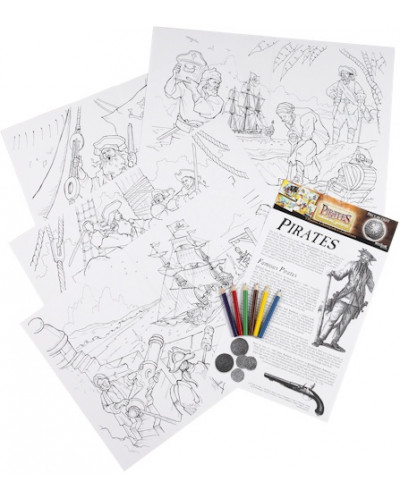Pirate Educational Colouring Posters
- Product Code: PPOP
- Availability: In Stock
- Pack Qty: 10
Product Description: The Pirate Colouring Posters consists of four A3 size colouring sheets, six colouring pencils and a Pirate factsheet.
The colouring posters include an image of a pirate ship attacking a colony, pirates attacking a ship, Blackbeard on his ship and pirates burying their treasure.
The factsheet explains about pirates, famous pirates, the pirate life and there is also a crossword to complete. There is a colourful header card that has pictures showing how the posters could be coloured in and information about the Piece of Eight ‘pirate treasure’ coin. All are held in a clear cellophane bag.
Information: The term ‘Pirate’ means simply “one who plunders on the sea”. Those who led this life fell into several categories: “privateers” were sea raiders with a government licence to pillage enemy ships; “buccaneers” were 17th century pirates who menaced the Spanish in the Caribbean and “corsairs” were privateers and Pirates who sailed in the Mediterranean. As long as people have been moving goods or items of value in ships there have been pirates. Examples of these early pirates can be seen on early Greek vases and are mentioned by the Romans. The young Julius Caesar (c.102 – 44BC) was kidnapped by Pirates and was only released when a ransom was paid.
Edward Teach (or Thatch, or Drummond) (c. 1680 – November 22, 1718), better known as Blackbeard, was a notorious English pirate who had a short reign of terror in the Caribbean Sea between 1716 and 1718, during a period of time referred to as the Golden Age of Piracy. His best known vessel was the Queen Anne’s Revenge. From a base in North Carolina (with whose governor he shared his booty), Blackbeard terrorised the coastal settlements of Virginia and the Carolinas. He was finally killed on November 22, 1718, during an engagement with a force sent from Virginia. His body was decapitated, and his head affixed to the end of the bowsprit of his ship.
John Rackham, also known as Calico Jack Rackham or Calico Jack, was an English pirate captain during the early 18th century. His nickname was derived from the colourful calico clothes he wore. John Rackham is remembered for employing two of the most notorious female pirates of his time, Anne Bonny and Mary Read, in his crew. John Rackham and most of his crew were executed in Jamaica on 17 November 1720. Mary Read and Anne Bonny escaped execution by pleading they were both pregnant.
Mary Read had a harsh childhood. Her father died before she was born and her brother soon after. When she was about thirteen years old she boarded a man-o-war. A few years later she joined the army, where she met her future husband. After just a few months of marriage, her husband got sick and died. Mary joined the army again. This time she boarded a Dutch ship that sailed to the Caribbean. Almost at the end of its destination, Mary’s ship was attacked and captured by the pirate, Calico Jack Rackham who took all English captured sailors as part of his crew. This is where Mary met Anne Bonny another female pirate. Mary died in early 1721 while in prison, either by fever or during child birth.
Born on May 17, 1682 John Roberts, also known as Bartholomew Roberts was a Welsh pirate who raided shipping off the Americas and West Africa between 1719 and 1722. He was the most successful pirate of the golden age of piracy, capturing for more ships than some of the best-known pirates of this era such as Blackbeard or Captain Kidd. He is estimated to have captured over 470 vessels. He was eventually cornered and killed off the coast of Africa on February 10, 1722.
Pirates would raid colonies and ships in the search for plunder. The life of a pirate was very hard. They may have to deal with limited rations and disease as well as having to fight to the death when attacking other ships. Pirate ships were often armed with many cannons and the crew were extremely brutal. They would attack colonies and ships in search of treasure and would kill anyone who got in their way. If they were caught the penalty for piracy was death. Convicted pirates were shown little mercy and were hung and their bodies left to rot in gibbets (iron cages) as a warning to other pirates.
According to popular belief, pirates often buried their stolen fortunes in remote places, intending to return to them later (often with the use of treasure maps). The pirate Captain Kidd buried a small cache of treasure on Gardiner’s Island but it was removed and sent to England to be used as evidence against him. He was found guilty of murder and piracy and hung on May 23, 1701.
Tags: Pirate, Educational, Colouring, Posters, Pirates

